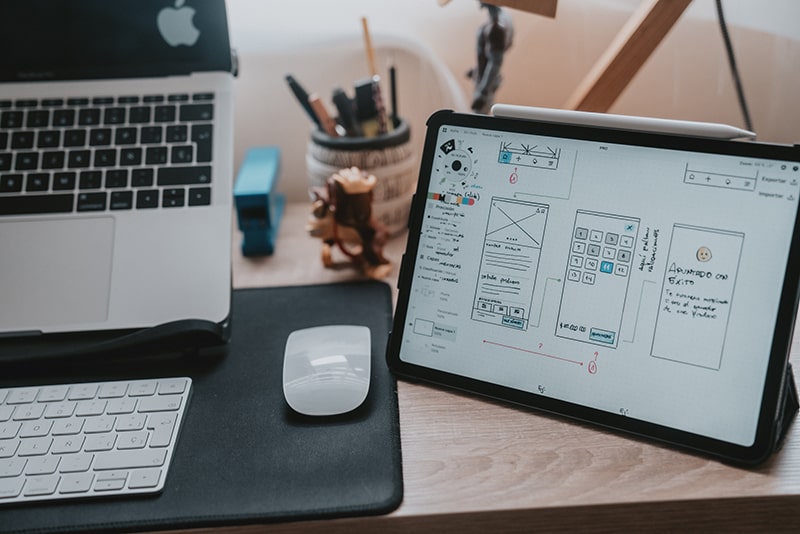If you ever asked yourself: what does a UX designer do? We are here to answer this question!
UX designers create user experiences that are easy to use, enjoyable to interact with, and meet the needs of their users. They study the behaviors and needs of users in order to create products that work well for them.
UX designers create products that are easy to use and enjoyable to interact with
In a nutshell, UX designers create products (apps, websites, electronic devices) that are easy to use and enjoyable to interact with. UX designers are responsible for making sure that the product is easy to use. They spend time researching what users want and need from the product, brainstorming ideas on how to solve those problems or meet those needs in an innovative way, gathering feedback from potential users, and testing out different prototypes of their ideas—all before the person writing code ever gets involved.

UX designers study the behaviors, needs, and motivations of users of a product
The first thing to know is that a UX designer studies the behaviors, needs, and motivations of users of a product. This can be done in many ways, including:
- User research
- Interviewing users
- Surveys (e.g., asking them to fill out a survey)
- Ethnographic research (e.g., following people around with a clipboard and asking them questions)
- Participatory design (also called co-design or design theater).
User research
User research is the process of finding out what people think about your product. It helps you understand what users are thinking and feeling when they use your product or service.
User research helps you build better products and improve your business in many ways:
- You can find out if people like or dislike a feature on their website, app, store, etc. This will help you make changes so users are more satisfied with their experience using your product or service.
- You can learn how to improve an existing feature by understanding how it’s working now (and where there might be problems).
- For example, let’s say that when a user makes an account on a website they have to fill out several fields before hitting submit; this will take time but it’s necessary since the data needs to be stored securely anyway. In this case, user research would reveal whether most people really care about filling out all those fields or whether they just want an account with minimal information entered – then depending on what you learn from talking with real users, you could decide whether making changes would improve the overall experience for everyone involved (or just some group of people).

The research will help you identify patterns and reoccurring issues in the user experience
The first step in the process of becoming a UX designer is to research your target audience and identify patterns and reoccurring issues in the user experience. This will help you understand how users interact with a product or service, listen to user feedback and incorporate it into your designs, learn about the target audience for your product or service, talk to people who are using your product or service, learn about other user experiences (such as competitors), collect data on users’ preferences, needs and wants.
Use wireframing and prototyping to visualize how a product will work for its users
A wireframe is a low-fidelity prototype of the user interface. Wireframes are used to communicate ideas and test the user experience before any code is written. They serve as a blueprint for how your product will look, feel, and function.
The term wireframe comes from the web design industry where it refers to basic sketches of interfaces—a bare-bones outline that describes what each page looks like (but not necessarily how it works). As this definition implies, wireframes are not intended for end users; they’re used primarily by designers and developers who need to see what’s going on behind the scenes so they can build out ideas or fix problems early on in the development process.
For example, if you want to create an app that lets people order pizza from their phones but don’t know where exactly those buttons should go yet, you could create a quick wireframe that shows each piece of content with placeholder text like “Order Pizza” or “Create Account.” That way when users click around within this interface (which isn’t real code), they’ll still be able to view all possible combinations without getting confused—and without spending hours designing something only half right!

You’ll also need to test your ideas!
To make sure that you’re producing something your audience will love, you need to test your designs as soon as possible. Testing early and often helps keep the design process on track—and saves time and money.
You can run tests on early versions of your product or app, get feedback from users and revise until you have something that works.
It’s also important to make sure that the people who are testing your product have relevant experience and knowledge about your industry, so they can give useful feedback. If they are not representative of your target audience (for example, if they don’t live in a big city), then their comments might not be very useful!
If you’re interested in UX design, you don’t need to be a programmer!
If you’re interested in UX design, you don’t need to be a programmer. However, you should know how to code at some level since it’ll make communicating with developers easier. This isn’t necessary for most designers who work on more established products with established specifications. But if you’re working on a new product or feature from scratch, having some basic coding skills will definitely come in handy when it comes time to test and iterate your designs with real people.

Career in UX
Some companies hire entry-level UX designers without any formal education required as long as they have some sort of portfolio of projects they’ve worked on. If you don’t have a portfolio, you can still get a job if you have some experience with design. If neither of these options is for you, consider taking some classes or doing projects for free so that your work can be used to create your first one.
UX design offers lots of career options no matter what type of role you’re looking for
UX design is a broad term that encompasses many different jobs. As a result, UX designers can work in many different roles across many different industries.
For example, you can be a UX designer for a company like Google or Facebook and spend your days researching what new technologies are coming out and how to incorporate those into their products. You can also be a freelance designer who works with clients directly to create websites or apps for them, or even create your own startup!
Whatever way you choose to go about it, the field of UX design is growing rapidly—and there’s never been a better time than now to get started!

Conclusion
In the end, what matters is that you enjoy the work and make it a lifelong career. If you’re still not sure what path to take, don’t worry! There is no right or wrong way to become a UX designer—just do what feels right for you. We hope this article answered the question “what does a ux designer do?” and you’ve learnt more about this profession.


